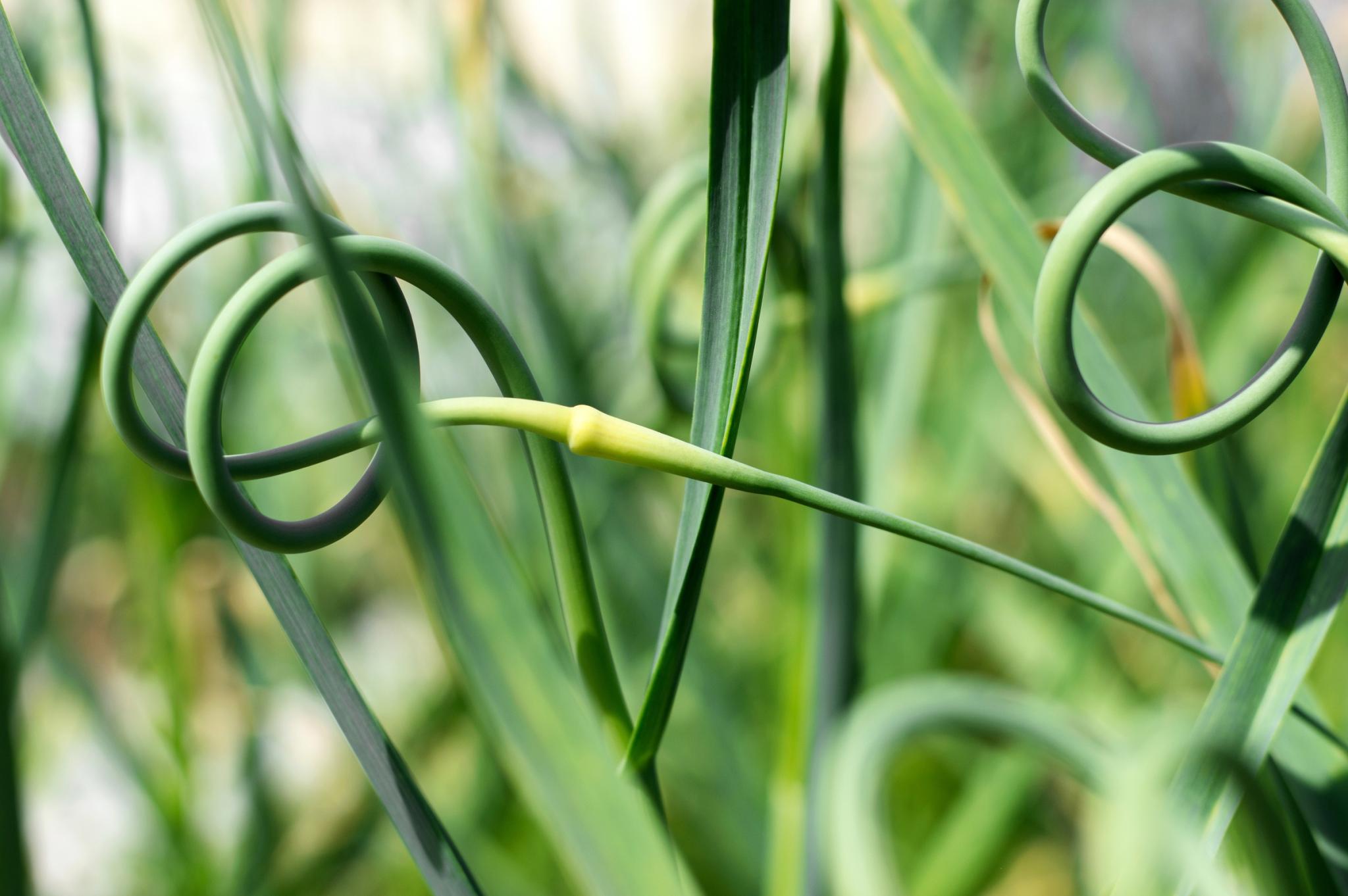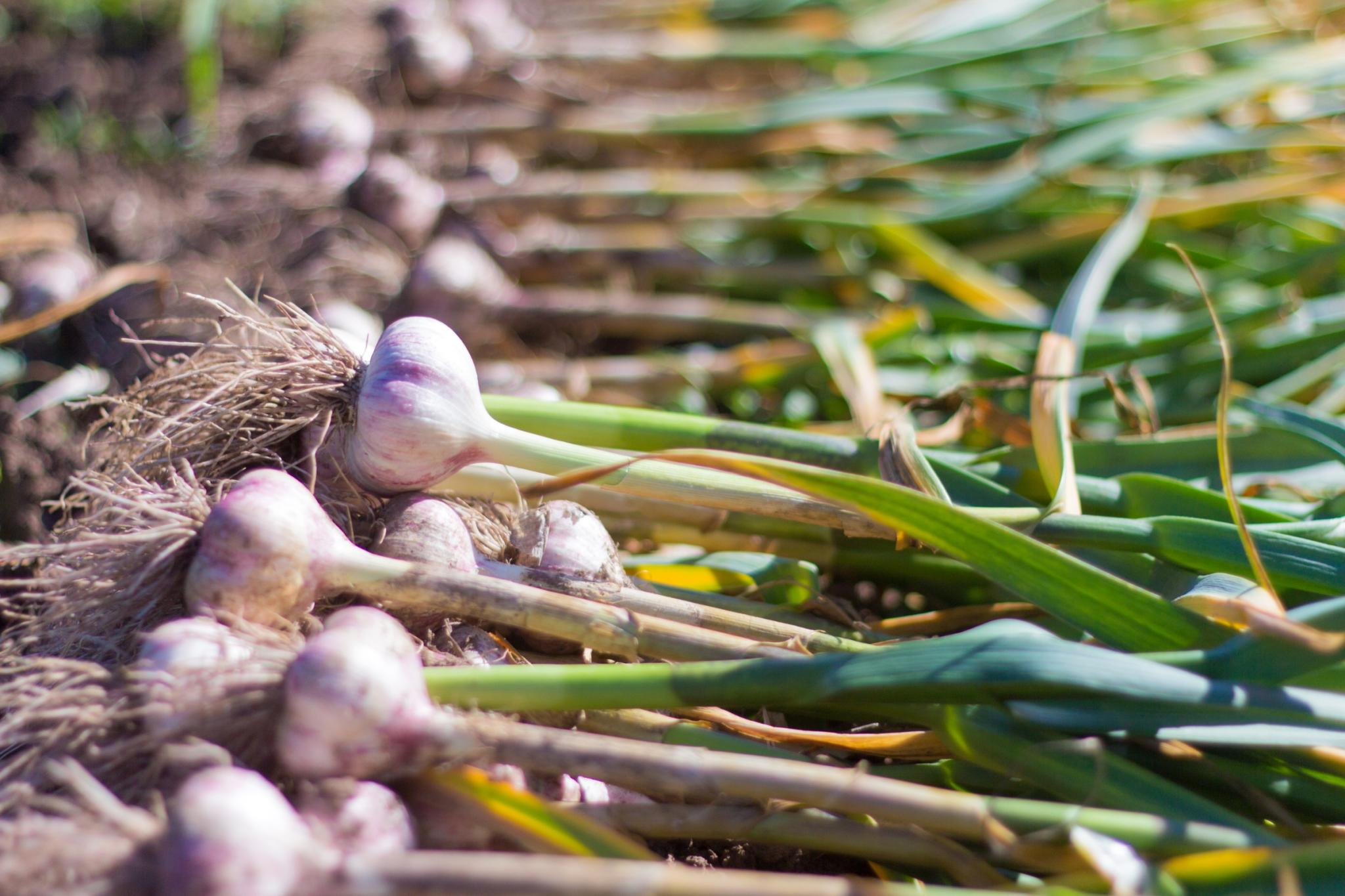
Easy garlic growing tips—from choosing varieties to planting cloves and harvesting tasty bulbs
Read Next
Types
Before you choose a variety of garlic, you need to consider your climate, which determines whether you plant a hardneck or softneck variety. Then you need to consider your cooking because different varieties have different taste profiles, from mild to sweet to bold to spicy!
Hardneck Garlic
Hardnecks are the best choice for Northern gardeners. This variety is extremely cold hardy for harsh winters. These grow one ring of fat cloves around a hard stem, with fewer but larger cloves per bulb than softnecks.
Bonus! Hardnecks produce flower stems, aka “scapes,” which must be cut to encourage the bulbs to reach their full potential. The scapes themselves are an early summer treat, delicious if chopped into salads or added to stir-fries.
Popular hardneck varieties: ‘Music’ (on the mild side yet rich and mellow); ‘Chesnok Red’ (mild and sweet, creamy texture when roasted); ‘Early Italian’ (sweeter flavor that won’t overpower dishes); ‘German Red’ (robust, classic garlic flavor which cooks love); ‘Spanish Roja’ (strong and hot, heirloom with classic garlic flavor).
Softneck Garlic
Softnecks are more common with Southern gardeners, growing well in warm climates with warm winters. They have more intense flavors and tend to grow bigger bulbs with smaller cloves per bulb because energy is not being diverted to top-set bulblets like hardnecks.
They do not have scapes, but they store better than hardnecks. Like their name suggests, they have necks that stay soft after harvest and, therefore, are the types that you see braided together.
Popular softneck varieties: ‘California White Early’ (classic moderate garlic flavor, most popular grocery store type, harvest in spring); ‘California White Late’ (harvest in summer); ‘Inchelium Red’ (wonderful but mild garlic flavor, superior storage life); ‘Silver White’ (classic garlic, great storage, excellent for beginner); ‘Lorz Italian’ (hot and zesty heirloom, popular with cooks).
Elephant Garlic
Elephant garlic isn’t a true garlic, but it is grown similarly to hardneck varieties, requiring a long, cool growing season in zones 3 through 9. Most types take about 90 days to harvest once growth starts. Despite its size, it has quite a mild flavor, more similar to onion and shallots than traditional garlic. Bulbs and cloves are large (up to one pound each!), with just a few cloves to a bulb.
See our complete video that demonstrates how to grow and harvest garlic!
Gardening Products
Cooking Notes
- Learn how to make your own garlic powder to easily spice up a recipe.
- Roasted garlic bulbs are also a favorite of ours!
- Around the summer solstice (late June), hardneck garlic sends up a seed stalk or scape. Allow it to curl, then cut off the curl to allow the plant to put its energy into bulb formation. Use the scapes in cooking the same way you would garlic bulbs. We like to stir-fry scapes the way we cook green beans—similar, with a spicy kick! Note that they get more fibrous and less edible as they mature.

These bulblets will, as you say, usually produce a full head with cloves in two years (producing a round, with no cloves, the first year). Some gardeners store the harvested bulblets in a dry place and then plant them in the fall. For more information, please see response to the second post below yours.
You can plant the bulblet in the garden; some gardeners may store it in a dry place and then plant in fall. In cold areas, you might want to provide a good layer of mulch over winter. The bulblet has a very hard coat, so some people soak it for 24 hours before planting, and sometimes also nick it a bit to help water penetrate. Others have had success without any preparation. The bulblet will usually sprout next spring. It will form a small "round," which is a bulb without cloves. You can harvest the round that summer, or let it grow another year, when it will likely grow and divide into large cloves. So, from bulblet to a large bulb with cloves, it takes 2 years.
Yes, the garlic "scrapes" are the flower steps that grow before the before the bulbs mature. Most gardeners will cut them off so that the plant focuses on growing bigger bulbs. You can eat them! Just harvest when they're young and curly; it's best to cut them in the afternoon. Add to salads, soups, egg dishes, and pastas. Stir-fry or sauté in olive oil. Just trim off the bottom of the stems and the tips of the flower heads.
- « Previous
- 1
- 2
- …
- 10
- Next »














Comments